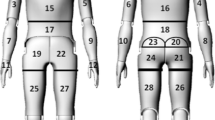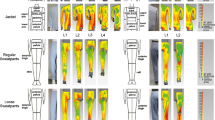Abstract
The localized thermal insulation value expresses a garment’s thermal resistance over the region which is covered by the garment, rather than over the entire surface of a subject or manikin. The determination of localized garment insulation values is critical to the development of high-resolution models of sensible heat exchange. A method is presented for determining and validating localized garment insulation values, based on whole-body insulation values (clo units) and using computer-aided design and thermal analysis software. Localized insulation values are presented for a catalog consisting of 106 garments and verified using computer-generated models. The values presented are suitable for use on volume element-based or surface element-based models of heat transfer involving clothed subjects.


Similar content being viewed by others
Notes
Poser 5,Curious Labs, Inc., Santa Cruz, CA, USA
Rhinoceros 3; Robert McNeel & Associates, Seattle, WA, USA
Radtherm; ThermoAnalytics, Inc., Calumet, MI, USA
Abbreviations
- A :
-
Surface area (m2)
- C j :
-
Fraction of body surface covered by garment j
- f cl :
-
Clothing area factor
- \(\bar h\) :
-
Average convection coefficient (W m−2 °C−1)
- h r :
-
Linearized radiation coefficient (W m−2 °C−1)
- I cl :
-
Garment insulation value (clo)
- Q :
-
Heat transfer rate (W)
- R :
-
Thermal resistance (m2 °C W−1)
- T :
-
Temperature (°C)
- T a :
-
Ambient (air) temperature
- T 0 :
-
Operative temperature (°C)
- \(\bar T_{\rm s} \) :
-
Area-weighted mean surface temperature of the manikin (°C)
- U :
-
Net heat transfer coefficient (W m−2 °C−1)
- *:
-
Localized quantity
- a:
-
Air layer
- b:
-
Body
- cl:
-
Clothing surface
- hf:
-
Hands and feet
- j:
-
Garment index number
- s:
-
Surface
- T:
-
Total (entire manikin)
- uncl:
-
Nude surface
References
Adair ER, Berglund LG (1992) Predicted thermophysiological responses of humans to MRI fields. Ann N Y Acad Sci 649:188–200
Ambs R (2002) Improved passenger thermal comfort prediction in the preprototype phase by transient interior CFD analysis including mannequins. SAE Technical Paper 2002-01-0514, Society of Automotive Engineers, Inc, Warrendale
ASHRAE (2001) Fundamentals handbook. American Society of Heating, Refrigeration and Air-Conditioning Engineers, Atlanta, pp 8.1–8.29
ASTM (1998) Standard test method for thermal transmittance of textile materials. D 1518–1585:380–387
ASTM (1999) Standard method for measuring the thermal insulation of clothing using a heated manikin. F 1291–1299:1–4
Charkoudian N (2003) Skin blood flow in adult human thermoregulation: how it works, when it does not, and why. Mayo Clin Proc 78:603–612
Curlee JS (2004) An approach for determining localized thermal clothing insulation for use in an element based thermoregulation and human comfort code. MS Thesis, Michigan Technological University
Fiala D, Lomas KJ, Stohrer M (1999) A computer model of human thermoregulation for a wide range of environmental conditions: the passive system. J Appl Physiol 87:1957–1972
Fiala D, Lomas KJ, Stohrer M (2001) Computer prediction of human thermoregulatory and temperature responses to a wide range of environmental conditions. Int J Biometeorol 45:143–159
Fortney SM, Vroman NB (1985) Exercise, performance and temperature control: temperature regulation during exercise and implications for sports performance and training. Sports Med 2:8–20
Han T, Huang L, Kelly S, Huizenga C, Hui Z (2001) Virtual thermal comfort engineering. SAE Technical Paper 2001-01-0588, Society of Automotive Engineers, Inc, Warrendale
Holmer I (2004) Thermal manikin history and applications. Eur J Appl Physiol 92:614–618
ISO (1995) Ergonomics of the thermal environment–estimation of the thermal insulation and evaporative resistance of a clothing ensemble. Standard ISO 9920:1995(E). International Organization for Standardization, Geneva, Switzerland
Kotte A, van Leeuwen G, de Bree J, van der Koijk J, Crezee H, Lagendijk J (1996) A Description of discrete vessel segments in thermal modelling of tissues. Phys Med Biol 41:865–884
McAdams WH (1954) Heat transmission, 3rd edn. McGraw-Hill, New York
McCullough EA, Jones BW, Huck J (1985) A comprehensive data base for estimating clothing insulation. ASHRAE Trans 91:29–47
McCullough EA, Jones BW, Tamura T (1989) A data base for determining the evaporative resistance of clothing. ASHRAE Trans 95(2):316–328
Pellerin N, Deschuyteneer A, Candas V (2004) Local thermal unpleasantness and discomfort prediction in the vicinity of thermoneutrality. Eur J Appl Physiol 92:717–720
Rugh JP, Farrington RB, Bharathan D, Vlahinos A, Burke R, Huizenga C, Zhang H (2004) Predicting human thermal comfort in a transient nonuniform thermal environment. Eur J Appl Physiol 92:721–727
Sessler DI (2000) Perioperative heat balance. Anesthesiology 92:578–596
Stolwijk JAJ (1970) Mathematical model of thermoregulation. In: Hardy J, Gagge A, Stolwijk J (eds) Physiological and behavioral temperature regulation. Charles C. Thomas, Springfield, pp 703–721
Wissler EH (1985) Mathematical simulation of human thermal behavior using whole body models. In: Shitzer A, Eberhart R (eds) Heat transfer in medicine and biology: analysis and applications, vol 1. Plenum, New York, pp 325–373
Wyon DP, Larsson S, Forsgren B, Lundgren I (1989) Standard procedures for assessing vehicle climate with a thermal manikin. SAE Publication 890049, Society of Automotive Engineers, Inc, Warrendale, pp 383–393
Yang W (1989) Biothermal fluid sciences: principles and applications. Hemisphere, New York
Acknowledgements
This work was supported by the Small Business Innovation Research (SBIR) Program and administered through the Office of Naval Research (ONR). The Program Officer was CDR Stephen Ahlers of ONR and the Technical Monitor was Dr. John Ziriax of the Naval Health Research Center Detachment at Brooks City Base. The views, opinions and/or findings contained in this report are those of the authors and should not be construed as official Department of the Air Force, Department of the Navy, Department of Defense or U.S. government position, policy or decision unless so designated by other documentations. Trade names of materials and/or products of commercial or non-government organizations are cited as needed for precision. These citations do not constitute official endorsement or approval of the use of such commercial materials and/or products. Approved for public release; distribution unlimited.
Author information
Authors and Affiliations
Corresponding author
Rights and permissions
About this article
Cite this article
Nelson, D.A., Curlee, J.S., Curran, A.R. et al. Determining localized garment insulation values from manikin studies: computational method and results. Eur J Appl Physiol 95, 464–473 (2005). https://doi.org/10.1007/s00421-005-0033-4
Accepted:
Published:
Issue Date:
DOI: https://doi.org/10.1007/s00421-005-0033-4




